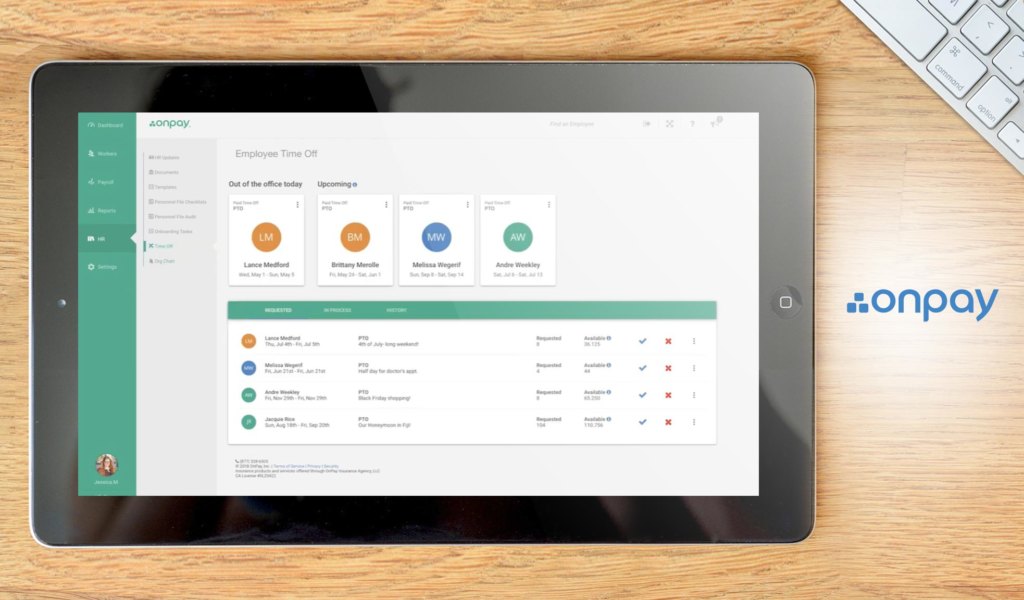Payroll administration is one of the most essential business processes your company performs, yet one of the most cumbersome and time-consuming daily activities. It doesn’t generate direct revenues, so keeping this process to a bare minimum in terms of time and cost means savings and more efficiency for your business. This is why you need payroll software so that you can focus on income-generating strategies and daily core tasks.
The American Payroll Association estimates that payroll automation reduces costs from invoice and paycheck errors by 80%. The system requires little input from you, usually just wage details and work hours. Wage calculations, tax withholding, deductions, and other backend processes are managed by the system. What is payroll software? To find out, keep on reading. When you’re finished with this guide, you’ll gain a full understanding of such a system beyond the definition of payroll management software. You’ll appreciate the benefits of payroll software and its most important aspects. You can use this newfound knowledge to aid your purchase journey and choose the best option for your business.

What is Payroll Software Guide Table of Contents:
- What are examples of payroll software?
- Why use a payroll software?
- What are the types of payroll software?
- What does a payroll management software do?
- What are the factors to consider when getting payroll software?
- How much does a payroll software cost?
- What are the potential issues with payroll software?
- What are the latest payroll trends?
What are examples of payroll software?
Here are a few examples of payroll management software:
Quickbooks Payroll
Part of the Intuit QuickBooks product lineup, Quickbooks Payroll is a solid payroll management platform that makes it easy to prepare, file, and distribute payroll. From payroll calculation and tax computing to check distribution and direct deposits, this payroll solution offers everything organizations need to pay their employees correctly and on time
Gusto
Gusto is a standalone payroll software built for small business owners. The solution comes with benefits and HR functions like employee onboarding, time-off tracking, and document management. Furthermore, it helps users automate payment, calculation, and submission of a company’s payroll taxes for all government levels.
Rippling
Rippling improves efficiency and security by automating human resource activities such as onboarding, payroll administration, and electronic document management. The platform’s personnel management platform integrates with over 500 apps and provides a centralized method for monitoring and automating human resource operations.
OnPay
OnPay is a simple-to-use yet powerful payroll software for small and medium-sized businesses. This solution can calculate your federal and state payroll taxes, make tax payments, and file tax forms correctly. The vendor is confident of its accuracy and will take responsibility for any mistakes in the tax filing. OnPay securely stores pertinent information, manages payrolls quickly, and automates certain tasks and operations.
BambooHR
BambooHR is the definition of a robust Human Resource Information System-integrated payroll management. It caters to small and medium companies. It has a flexible core system and pricing model packaged with custom features, which allow users to set fields, tables, and tabs, create user groups and integrate with related systems like applicant tracking and payroll solutions.
Trolley
Trolley (formerly Payment Rails) is an accounts payable software solution that is best for firms with moderate to high-volume payables. The software provides end-to-end support for accounts payable operations through the use of a simple and intuitive user interface.
Xero
Xero is an accounting-integrated payroll management system designed for small businesses that need to integrate payroll with online accounting. It’s a reliable BambooHR alternative that includes pension and finance management, as well as core accounting, inventory, bank reconciliation, and purchase orders.

Your KPIs are readily viewed and monitored on QuickBooks Payroll.
Why use a payroll software?
Payroll software lends to your business automation, data centralization, templates, integration, and customization that, together, deliver the following major benefits. Here are more scenarios of the purpose of payroll management software, the better you appreciate this system beyond answering the question–what is payroll management software?
- Save time; avoid errors. Payroll processes are time-consuming and error-prone when manually done. A misplaced “0” or decimal point can wreak havoc on your finances. Moreover, the Sarbanes-Oxley Act of 2002, which the US Congress had passed in response to financial malpractices like the Enron and Tyco scandals, added complexities to regulatory compliance, including payroll, to ensure data integrity. You can turn to payroll automation to avoid inaccurate financial statements and penalties. It syncs and consolidates employee data and regulatory rules and automates calculations, leaving no room for oversight.
- Pay employees correctly. Paycheck mistakes not only waste your time, but they also build distrust and can harm employee morale. Even when mistakes are honest, they damage your reputation and, worse, can fuel demoralizing rumors. Payroll software keeps calculations consistent and accurate. It automatically factors in key items like salary grade, benefits, expenses, allowances, and deductions when processing wages.
- Pay taxes correctly. If your employees and contractors are spread out across the US or you have offshore teams, tax compliance will bog you down. With nearly 10,000 tax jurisdictions in the US alone, withholding federal, state, and local payroll taxes comes in myriad forms and ways. Most payroll automation has built-in location-based tax calculations and reporting or, at least, a system that lets you preset tax rules. Automation makes it easy to compute taxes owed and paid per employee, while templates speed up submission of scheduled reports to regulatory agencies. And when tax law changes, most vendors immediately update their systems. You’ll find payroll management software a necessary tool to avoid costly late payment penalties.
- Build transparency. Disputes are settled quickly and clearly with drill-down access to timesheet, benefits, agreements, and other related data. Payroll systems can break down records to granular level and pinpoint with accuracy the points of dispute, be it leaves, absences, expenses, adjustments, collective labor benefits, or other wage-related items.
- Quick access to employee data. Payroll automation centralizes employment data, such as contracts, CBAs, performance records, leaves, timesheets, and conversations. Users with system permission can quickly access the related data from various devices or platforms. Keeping staff records in one place has other merits beyond payroll, for instance, for job evaluation or opex costing.
- Customize reports. Whether payroll is attached to HR or accounting, payroll automation can customize reports based on rows and columns, fields, and other rules. You can define what items go into a report, for instance, payslips, benefits, expenses, or current or historical data. Generating recurring reports is easily standardized and scheduled with smart alerts.
- Added security. The simplicity and ease-of-use of today’s cloud payroll solutions allow you to manage payroll internally. Relying on a third party to handle salaries exposes sensitive data. With payroll management software, employee data are accessible only to you and your authorized staff.

OnPay offers a wide range of features with tangible benefits for your payroll processes.
What are the types of payroll software?
Payroll management software can be classified by deployment (cloud vs. enterprise), business size (small business vs. enterprise), and target market (general vs. industry-specific). There is another way to distinctly classify payroll software, one that may impact your workflows.
- Integrated payroll management. Payroll, accounting, and HRM have overlapping processes. Thus, often, payroll management is integrated as a module in accounting software, HRM, or an organization-wide business system like ERP. It can be a standard feature or separately charged as an add-on. Integrated payroll management covers core tasks like payroll processing, income tax calculations, and paycheck printing. Examples: BambooHR, Xero, Wave, UltiPro
- Dedicated payroll management. These are standalone apps that go beyond core features with specialized functions as time-tracking and attendance, customized reporting, benefits administration, and even a tax planner. A good dedicated payroll app should easily integrate with other HRM and accounting systems. This type of payroll system is popular among payroll services and small businesses. Examples: Gusto, Intuit Payroll, SurePayroll
What does a payroll management software do?
You’ve learned what is payroll management software, but what are its uses? Payroll management software automates, streamlines, standardizes, and centralizes payroll processes. Specifically, the following features of payroll management software accomplish the myriad aspects of payroll, from calculating wages and taxes to planning employee benefits and managing attendance.
- Payroll management. Wages are automatically calculated based on your preset schedule: daily, weekly, bi-weekly, or monthly. This is one of the main advantages of payroll management software. The module consolidates wage-related items like attendance, salary grade, benefits, reimbursements, leaves, advances, withholding taxes, terms, and policies, etc. to compute wages. Most solutions need only to be manually set up with your rules. Then the system takes over the payroll process. It can be customized along multiple pay and benefits structures and further configured for specific employees or contractors.
- Leaves management. This module allows employees to submit leave claims and monitor their leave balance, while managers can review such requests and notify employees of approved or declined claims. The module also calculates accrued leaves for wage calculation.
- Expense management. Expenses, deductions, loans, advances, and other employee costs are entered, tracked, and calculated in this module. Some payroll systems feature a loan ledger to account for all approved employee loans. This module may also handle reimbursements based on approved expenses.
- Benefits, bonus management. The module manages various benefits claims, including CBA, allowances, and other employee perks. Some solutions feature a knowledge base of benefits where employees can select and submit a claim.
- Income tax & deductions. This feature processes pre- and post-tax deductions. It helps you comply with various state and federal taxes and social security requirements. The system automatically does the calculations based on the latest regulations. The more advanced payroll management solutions provide tools for income tax projections, TDS estimates, and annual tax-saving investments.
- Time and attendance tracking. Standalone payroll management software may include timesheets or a time-tracking feature to manage attendance. This module tracks absences, increments, leaves, and attritions and syncs these data with wage calculations. Some advanced features let you manage multiple shifts and transfers and biometric integration to show real-time clock-in/out.
- Reports, payslips, forms. This is another key feature, which generates payroll reports like salary statements, benefits reports, or leave summaries. Employees can also access this platform to check or print payslips. Likewise, payroll forms can be printed like 941, 943, 944, W2, and W3. Regulatory forms such as Form 16, Form 12BA, and Form 12C may also be downloaded and printed.
- Record-keeping. Payroll management software also acts as a central repository of employee records and related documents. This feature usually includes document management to handle files like offer letter, experience letter, employee profiles, organizational charts, and applicable statutes for labor, tax, and occupational safety.
What are the factors to consider when getting payroll software?
We’ve answered the question what is payroll management software earlier in the article, let’s now look at how it works. It depends on many factors. Payroll management software comes in various packages. Some are bundled with HRM, ERP, or accounting systems, while others are independent solutions. Before committing to a plan, consider the following key factors to ensure you’re getting the best value off your budget.
- Cloud vs. on-premise. As with most business processes, payroll management can be cloud or on-premise. The list of pros and cons is long for both versions. Cloud has low capital outlay, regular updates, easy setup, near-zero maintenance, readily available support, multi-device accessibility, flexible features, and price points. But it commits you to a perpetual monthly cost, and sensitive data are stored in servers you don’t have control over. On the other hand, on-premise requires massive investment for licensing and servers, in-house technical talent to install and maintain the system, and downtime for upgrades. But data stays with you, and there are no recurring costs. We have an article that details cloud vs. on-premise comparison, which applies to your other business processes too.
- Total cost of ownership. License fees or monthly subscription isn’t the only cost that comes with payroll management software. Read the fine print and check for hidden fees. Typical costs that can quickly bloat the budget include core features that are separately charged; setup fee; system upgrade; per-user fee; per-paycheck fee; training fee; and support fee. Also, mind lock-in terms, which may strap you down with features you’re paying for but don’t need.
- Regulatory compliance. Make sure the payroll system supports tax laws, social security requirements, and applicable local regulations. These include the ability to set the right wage deductions, adjustments, and generating required reports for different government agencies. Likewise, a good payroll solution automatically upgrades the system for tax changes, so your processing is consistently compliant.
- Key features. Focus on key payroll functions that meet your unique requirements. For example, how do you pay employees? If via direct deposit make sure the system allows bank synchronization; if through paychecks, look for software that prints checks. Other key features include tax withholding (does the system support local laws?); pay period (daily, weekly, monthly?); and supplemental payment (does it support bonuses and commissions? contractual service?).
- Scalability. Your payroll management system should stand the test of time and match your growth pace. Look ahead in five years and anticipate what features you’ll be needing. For fast-growing companies, these can mean more users, more employees, more branches, possibly offshore units, and other additional operational elements that impact payroll. In general, cloud payroll systems are more flexible at scaling up features, alongside the corresponding price tiers.
- Integration. If the payroll solution isn’t part of a larger system like ERP, HR, or accounting, it must at least integrate with them. As your business expands, payroll processes get more complex and will need to integrate with other applications, such as sales ledger, recruitment, timesheets, and reporting tools. Aside from system integration, you’ll need to think of compatibility with business and productivity apps you’re using. File export-import should work with standard formats like PDF, JPEG, DOC, CSV, and TXT. Integration with cloud storage is also a big plus for backing up records. If you think you need multimedia, look for systems that accommodate videos and graphics.

Gusto is an independent payroll system that can integrate with benefits and HR modules for onboarding, document management, and time-off tracking.
How much does a payroll software cost?
A payroll management system is priced differently by vendors, but there are underlying similarities. For example, many vendors charge by number of payee or user. If it’s an accounting-integrated system, the price may depend on the number of invoices or quotes. Payroll management, as a feature, can also be charged separately as an add-on. Here are examples of the cost of payroll management software.
- Gusto – Pricing is based on the number of features you require. Rates start at $39 per month.
- BambooHR – Pricing is by quote to match your needs with the right set of features.
- Xero – It offers three price points starting at $12 per month, with its most expensive plan at $65 per month. Its basic plan allows only for 20 invoices and quotes as well as five bills.
- Wave – It is 100% free for invoicing, accounting, and receipt scanning features. The vendor charges for payroll services in select countries.
- UltiPro – Pricing is by quote only.
What are the potential issues with payroll software?
- Incompatibility with other systems. This is perhaps the stickiest issue and can sow chaos to your automation plans. Not all payroll systems are designed to work with other systems like HRM, ERP, and accounting software. Imagine your frustration to find out your payroll system can’t manage employee records you’ve stored in another application. Always check for integration–how the system works with the apps you’re using–when looking for the best payroll management solution.
- Non-compliant features. Payroll management processes like in accounting are tightly regulated by local, state, and federal laws. The system must comply with regulations in an accurate and timely manner, which include correct withholding taxes, deductions, and reporting to relevant agencies. Likewise, the system has to be regularly updated for tax law changes or new regulations. Non-compliance costs you a lot in penalties and surcharges and wastes your time.
- Sensitive data in third-party hands. As with other cloud solutions, the issue of storing sensitive data like employee information and payroll details on vendor servers always rears its ugly head in cloud vs. on-premise debates. But if the vendor is reputable, then established security shouldn’t be an issue considering the alternative: how equipped and qualified is your company to secure its data?
- Incomplete features. Some payroll management system focus only on core functions as payroll administration and attendance. They leave out non-core but tools that may be key to your workflows. For instance, you may need to check printing, real-time reporting, benefits planning, and biometrics integration. The problem is exacerbated when you have an existing accounting solution with incomplete payroll features. Should you get another payroll system? In such a case, you’re better off looking at the big picture, maybe consider an ERP that addresses all your business processes.
- Too many features. Conversely, a small business with basic payroll needs may end up paying for a fully integrated system. Payroll is often a feature in bigger systems like accounting, HRM, and ERP. Make sure you pay only for the features that you need to keep this operation expense at the minimum.

What are the latest payroll trends?
How will payroll software work in the future? Let’s look at some of the trends shaping the category in the next few years.
- Hybrid solution. Where before the debate is on in-house vs. outsourcing, there is an emerging trend among companies to combine both. They turn to cloud payroll management to input data while depending on the vendor or a payroll service provider to process and deliver payroll on time and compliant to existing laws. This trend is evident in vendors like Quickbooks Payroll, which offers a free app and relies on payroll services for revenues. Startups are attracted to this setup to gain control over their data while freeing them up from the headaches of day-to-day administration.
- Mobile and self-service payroll. Mobile payroll apps let employees access their pay details and relevant data such as holidays, accrued leaves, and attendance. Employees can also print payslip or keep a digital file of it.
- Data-driven. Payroll management is becoming an instrument for data-driven strategic decisions. As it involves major costs and critical resources (talents), companies are turning to the vast volumes of data payroll management systems generate to find patterns and insights that help shape strategies and drive the company’s overall competitiveness. For example, the system can churn out employee turnover rate or overall company mood using leaves and absences as metrics, even if the system is not designed for business intelligence tasks.
- Machine learning. The technology is creeping its way into consumer gadgets (IoT) and, now, business solutions, payroll management systems notwithstanding. It’s a self-learning algorithm that studies your daily actions in the system and use these to refine procedures, navigation, and UI.




























Perhaps someone can help me. I need a VERY simple Payroll software on premise to use at church with only 5 employees. Just really need to calculate employee taxes, and quarterly payments. I am behind for last year and I need a software system where I can back track and input data to calculate taxes, etc. I only need the very basic. HELP!!
Leave a comment!